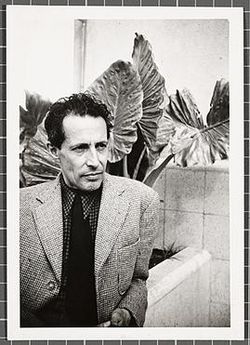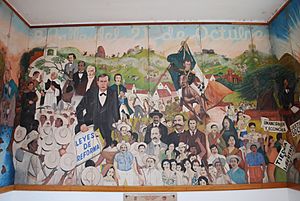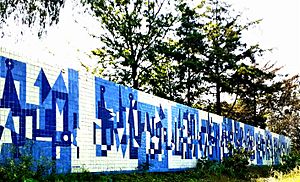Carlos Mérida facts for kids
Quick facts for kids
Carlos Mérida
|
|
|---|---|

Carlos Merida, ca. 1950 / Florence Arquin, photographer. Florence Arquin papers, Archives of American Art, Smithsonian Institution.
|
|
| Born | December 2, 1891 |
| Died | December 21, 1985 (aged 94) |
| Nationality | Guatemalan |
| Known for | Painting, Drawing, Printmaking, Lithography |
|
Notable work
|
El Verano (1981) Alcalde de Almolonga (1919) La puerta estrecha (1936) |
| Movement | Cubism |
Carlos Mérida (born December 2, 1891 – died December 21, 1985) was a famous Guatemalan artist. He was one of the first artists to mix European modern art styles with themes from Latin America, especially from Guatemala and Mexico.
He was part of the Mexican muralism movement, which focused on large public paintings. However, his style was different. He preferred abstract and geometric shapes instead of realistic pictures. Mérida is best known for his paintings on canvas and his large murals. Some of his murals even used glass and ceramic mosaics on big buildings in the 1950s and 1960s. One of his biggest murals, covering 4,000 square meters, was on the Benito Juarez housing complex. Sadly, it was completely destroyed in the 1985 Mexico City earthquake. A special monument to this work now stands at another complex in Mexico City.
Contents
About Carlos Mérida's Life
Carlos Mérida was born in Guatemala City. His birth name was Carlos Santiago Ortega, but he later changed it to Mérida because he liked how it sounded. His family also started using the Mérida name. He had a mixed background, with both Spanish and Maya-Quiché heritage. He was proud of this heritage throughout his life.
Early Interests and Challenges
When he was young, Carlos took both music and art lessons. Music was his first love, and he learned to play the piano.
From 1907 to 1909, his family lived in a small town called Almolonga in Guatemala. He continued his music and art studies there.
At age 15, Carlos had a problem with his ear that caused him to lose some of his hearing. Because of this, his father encouraged him to focus on painting instead of music. He felt sad about giving up music, but he found that art was a good replacement. After finishing middle school, his family returned to Guatemala City. He then went to a trade school and later to a science and literature institute. Here, he started to gain a reputation for being an "avant-garde" artist, meaning he liked new and experimental ideas.
Family and Travels
In 1919, Carlos married Dalila Gálvez. They had two daughters, Alma and Ana. Dalila came from a wealthy family and supported Carlos's dreams, even though her parents were unsure about the marriage. She passed away in 1974, ten years before him.
Mérida's first trip to the United States was in 1917, where he met the writer José Juan Tablada. Throughout his life, Mérida traveled to Europe many times. He went there to study art and to work as an artist and a diplomat. His early trips in the 1920s and 1930s connected him with new art movements in Europe. He also met famous Latin American artists, especially those from Mexico. His last trip to Europe was in the 1950s.
In 1963, he gave many of his paintings, prints, and mural sketches to the Universidad Nacional Autónoma de México (National Autonomous University of Mexico).
Carlos Mérida was one of several artists, like Diego Rivera, who wanted to promote the traditional crafts and folk art of Mexico and Central America. He was especially interested in Guatemalan art. He often included Mayan textiles or designs in his own artwork.
He passed away in Mexico City on December 21, 1985, at the age of 94.
Carlos Mérida's Art Career
Carlos Mérida's art career started when he was still a teenager. When his family moved back to Guatemala City, he met many artists and thinkers. At 19, he met the artist and writer Jaime Sabartés. Sabartés helped Mérida organize his very first art show in Guatemala City in 1910.
Studying in Europe
Since there were few opportunities for artists in Guatemala, Mérida traveled to Paris in 1910 with a friend. He lived and worked in Paris until 1914, traveling across Europe. This allowed him to meet important European artists like Amedeo Modigliani, Pablo Picasso, and Piet Mondrian. He also met Latin American artists studying in Europe, such as Diego Rivera. He showed his art in famous places like the Independent Salon in Paris.
In 1914, Mérida returned to Guatemala and saw his home country in a new way. He became very interested in its rich folklore and diverse cultures. His second art show in Guatemala in 1915 is considered the start of modern painting in Guatemala. Because he had spent time with Mexican artists in Europe, he decided to move to Mexico in 1919. This was after the main fighting of the Mexican Revolution had ended.
Working in Mexico and Beyond
Mérida is known for both his easel paintings (paintings on canvas) and his large murals. His first exhibition in Mexico was in 1920. That same year, he showed his work in the United States at the Hispanic Society of New York. He had many exhibitions in the U.S. and Mexico throughout his career.
In the 1930s and 1940s, Mexican painting became very famous. However, Mérida's work was different from the popular Mexican muralists, so it was sometimes harder for him to sell his art. He continued to work intensely in the 1950s, 1960s, and 1970s, creating designs, prints, stage sketches for dance, and tapestries. He loved to experiment with geometric shapes. His art was shown in major museums like the Metropolitan Museum of Art and the Museum of Fine Arts, Boston.
Some of his important artworks include Alcalde de Almolonga, Imágenes de Guatemala, and La mestiza de Guatemala.
Murals and Public Art
Mérida's early large-scale works were connected to the Mexican muralism movement. This was one reason he moved to Mexico after the Mexican Revolution. He joined a group called the Mexican Renaissance and worked with Diego Rivera as an assistant on a mural at the Bolivar Amphitheater. He also painted a mural called Caperucita roja y los cuatro elementos (Little Red Riding Hood and the Four Elements) at a children's library in the 1920s.
In the late 1940s, he started working on murals again. This led him to explore "plastic integration," which means combining art and architecture. In 1950, he went back to Europe to study mosaic techniques in Italy. His next big project was for the Benito Juárez housing project, where he created 4,000 square meters of art. The idea was for people driving by to easily see the artworks. As mentioned before, this work was destroyed in the 1985 earthquake.
Other big projects included glass mosaic murals at the Reaseguros Alianza Building in Mexico City (1953) and artwork at the Museo Nacional de Antropología (National Museum of Anthropology) in 1964. In Guatemala, he also created murals for buildings like the Palacio Municipal (City Hall) and the Bank of Guatemala.
Dance and Education
Besides painting and murals, Mérida also worked in education. In 1932, he helped start a dance school for the Secretariat of Public Education. He invited other artists and musicians to join. He led the school for three years, working with famous dancers like Ana Mérida, who was his daughter. For Carlos, dance was a way to express things that painting and music couldn't. His daughter Ana became a well-known Mexican choreographer.
His interest in dance also led him to design stage sets and costumes for 22 dance performances between 1940 and 1979. He was especially interested in indigenous dances, documenting many of them, some of which were very old. In 1942, he was invited to teach fresco painting at the North Texas State Teacher’s College, which is now the University of North Texas.
Awards and Recognition
Carlos Mérida received many awards and honors throughout his life. In 1957, he won a prize at the IV Bienal de São Paulo in Brazil. His first major recognition came in 1958 when he received the Order of the Quetzal from the Guatemalan government. This is a very high honor. An annual arts prize in Guatemala was later named after him.
In 1980, he received the Orden del Águila Azteca (Order of the Aztec Eagle), which is the highest honor Mexico gives to people from other countries. The Palacio de Bellas Artes (Palace of Fine Arts) held big art shows celebrating his work in 1981 and 1992. Since his death, there have been many other events to honor his art.
Mérida’s artwork can be found in important public and private art collections all over the world.
Carlos Mérida's Art Style
Carlos Mérida is most famous for his paintings on canvas and his murals, which he mostly created in Mexico. However, he also made engravings, designed stage sets, and worked with mosaics.
His artistic path is sometimes compared to that of Rufino Tamayo. Mérida generally avoided huge, story-telling paintings. He preferred working on canvas and was more interested in art itself than in politics. He loved to experiment with colors, shapes, and different art techniques. Music and dance were important to him throughout his life, and they influenced his paintings, making them feel rhythmic and poetic.
Artistic Periods
Mérida's art can be divided into three main periods:
- Figurative Period (1907 to 1926): His early work showed realistic figures. When he was in Europe, art was changing from Impressionism to Cubism, and he was influenced by artists like Modigliani and Picasso.
- Surrealism Phase (late 1920s to mid-1940s): This phase also came from his time in Europe, where he met artists like Paul Klee and Miró. During this time, he stopped painting realistic figures and became one of Mexico's first non-figurative artists, moving towards abstract art. This made him different from many other Mexican artists.
- Geometric Forms (1950 until his death): His focus on non-figurative art continued, but he started using more geometric shapes. These shapes were often linked to ancient indigenous cultures of the Americas, like the Maya. His work from this period is considered very thoughtful, representing ideas or concepts rather than just things.
New World Identity
Even though he was greatly influenced by European art trends, Mérida felt it was very important to highlight his American (New World) identity and culture. He combined European modern art with shapes and subjects specific to the Americas. He realized that European artists weren't very interested in what was happening across the Atlantic. This made him believe that there was a need to create truly American art. He felt this art would show the "original character which animates our nature and our race."
His work often showed influences from both the Mayan and Aztec civilizations, as well as the colonial period. He used indigenous people as symbols of Mexico after the Revolution. He even used traditional indigenous amate paper in some of his artworks. While he was part of the Mexican muralism movement, he actually started promoting indigenous designs seven years before Diego Rivera made Mexican painting famous. Many people consider him a pioneer of Latin American art because he painted elements like indigenous people and landscapes without making them overly emotional, which was new at the time. This focus on the New World was seen in his early works with folkloric images and also in his later, more abstract art. The discovery of the ancient Mayan city of Bonampak deeply inspired him. He took new ideas from the ruins, which led to his interest in combining painting and sculpture with architecture.
See also
 In Spanish: Carlos Mérida para niños
In Spanish: Carlos Mérida para niños



